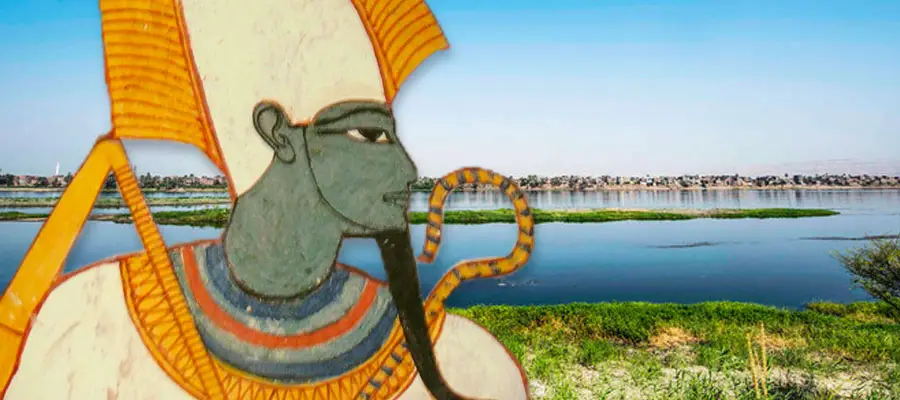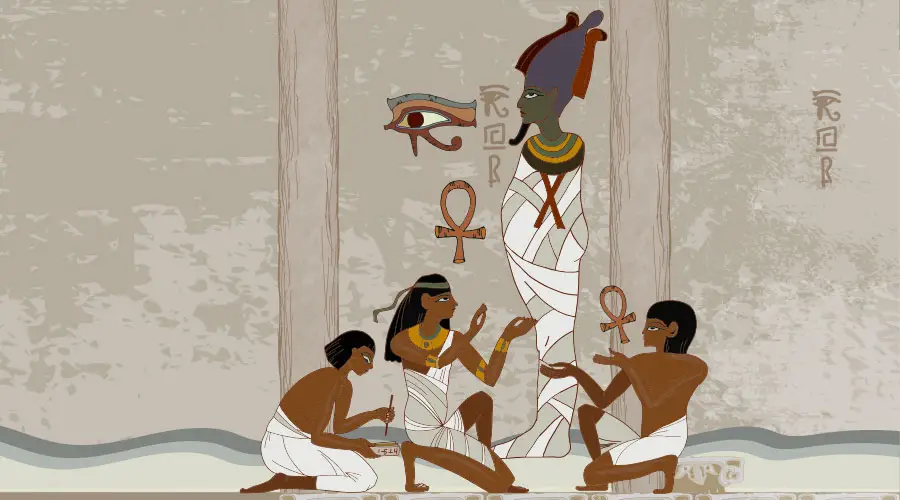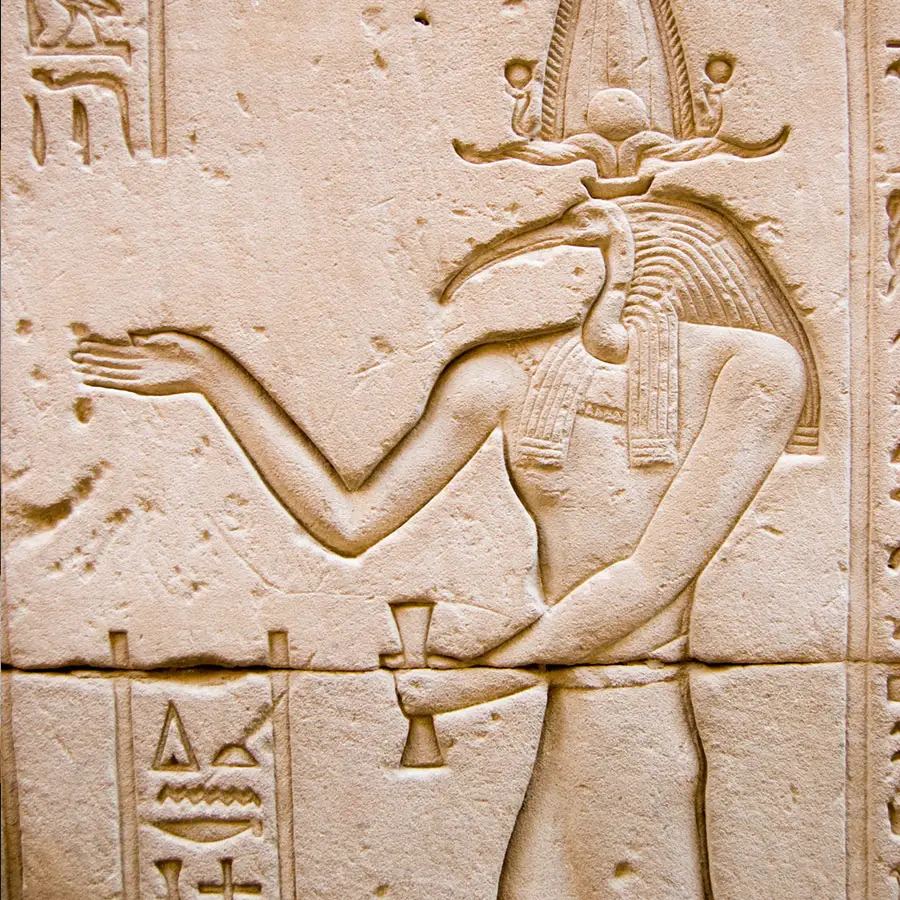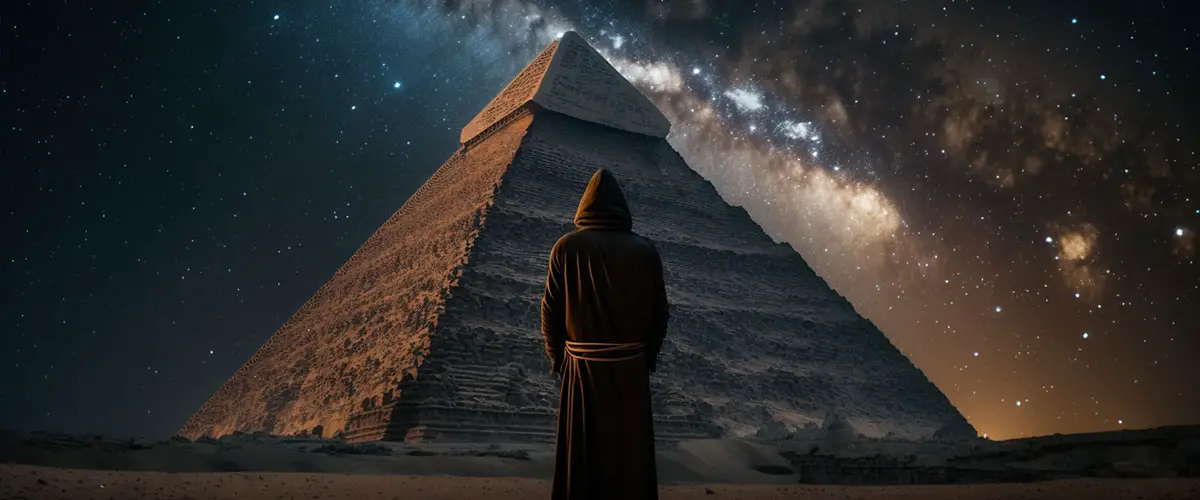Like most polytheist religions, the ancient Egyptians had a god of death. However, to the Egyptians, death was a very important concept, and they actually had many gods involved. In this article we are going to look at the question: who is the god of death in Egypt?
In ancient Egypt, the god of death was Osiris, one of the most important gods, who also represented fertility. However, the ancient Egyptians had complex beliefs about death, a process which involved several other gods, including Thoth, Maat, and Amemet, as the souls of the deceased journeyed to the afterworld.

Osiris, the Ancient Egyptian God of Death and Fertility
To the ancient Egyptians, Osiris was the embodiment of the dead, and the resurrected king. He was also the god of fertility, and It was believed by the Egyptians that he gave life and was responsible for the annual flooding of the Nile river, which allowed for abundant production of crops.
Depicted with green skin and a beard in the style of a pharaoh, wearing a crown and holding crook and flail. The crook is a stock with a hook on the end, used by shepherds. The flail is a tool used in agriculture to separate grains from their husks. The crook was a symbol of kingship, while the flail represented the fertility of the land. These symbols became part of the symbolism of the pharaohs, such as on the coffinette of Tutankhamun.
The Rivalry Between Osiris and Seth
Osiris was the ruler of Egypt, being the descendent of a lineage going back to Ra the creator of the world. He is then murdered and usurped by his brother Seth, Since Osiris represents order, and Seth disorder, as well as violence and chaos, their rivalry symbolizes the struggle between order and chaos.
After the murder, Seth cut the body into fourteen pieces, scattering them across Egypt. This was done when Seth learned that his wife Nephthy had conceived a child with Osiris. The killing was done by holding a banquet, where Seth invited his guests to lay in a coffin that he had made for the king. When Osiris lay in it, Seth nailed the lid of the coffin shut, weighed it down with lead, and sent it into the Nile river. He then tore the corpse into fourteen pieces, scattering them across Egypt.
Osiris’ wife Isis was able to find all of the pieces except for the phallus, and by performing the embalming rites for first time, was able to restore Osiris to life. This gave new life to Osiris in the underworld, who became the ruler and judge of the underworld.
The Struggle for the Throne Between Horus and Set
After Osiris was dead, Isis gave birth to his son, who was Horus. Horus goes on to become Set’s rival for the throne, eventually overthrowing him and restoring Maat (cosmic order).
Osiris and Reincarnation
It was also believed that through dedication to Osiris, it was possible to be reborn into the next lifetime after death. Many people would choose to be buried near the temple of Abydos, a place of pilgrimage, dedicated to the worship of Osiris, in the effort to demonstrate their dedication, and receive a fortuitus incarnation in their next lifetime.
Anubis the Egyptian God of Death during the Old Kingdom
Anubis is another Egyptian god, with the body of a man and the head of a jackal, who is associated with death. Especially in the earlier days of ancient Egypt, during the Old Kingdom, he was acknowledged as the god of death. Later, more focus was place on Osiris by the Egyptians, in terms of their rituals regarding death.
Anubis was particularly involved with the funerary cult, and the care for the dead. At times he was referred to as “He Who Is in the Place of Embalming”, as well as “the conductor of souls”. Anubis was considered the inventor of embalming. The first act of embalmment was conducted by Anubis on Osiris.

Ancient Egyptian Beliefs About the Afterlife
To the ancient Egyptians, their religious beliefs played a large role in their lives, and they believed in immortality and reincarnation. As writing flourished, the ideas about the journey to the afterworld was well known amongst the Egyptians. Their beliefs had three core ideas: the existence of the underworld, eternal life, and the rebirth of the soul. In order to achieve rebirth, one had to conduct themselves accordingly in their lifetime, as well as have the proper rituals performed after they passed away.
The Egyptian Practice of Mummification
They practiced mummification in order to preserve the body, so that the soul could return to the body. This would involve putting the liver, intestines, lungs, and stomach inside jars. The jars each had the head of a god in order to protect what was inside. They would leave the heart inside the body, because it was needed for when the deceased would travel to the underworld and be judged in the Weighing of the Heart ceremony.
The priests would place food and drink outside of the tombs of the deceased in order to provide for the person’s needs as they departed upon their journey to the afterworld.

The Opening of the Mouth Ceremony
The Egyptians had funerary texts of spells and prayers that would assists the dead on their way to the afterworld.
As part of preparation for the journey to the afterworld, the Egyptians would perform the “Opening of the mouth” ceremony on the mummy. Performed by priests, this elaborate ceremony involved burning incense and reciting incantations. They would touch the corpse of the mummy with ritual objects in order to restore the ability to touch, see, smell, hear, and speak
Journey to the Land of Duat
When the deceased journeyed to the afterworld, they would do so on a solar bark, a type of vessel like a boat. The journey was full of danger, as they would pass through the underworld full of multi-headed reptiles, serpents armed with knives, dragons that can breath fire. Eventually they would arrive at the land of Duat, where there were seven gates to pass through. At each gate they were required to recite a magic spell in order to pass through. Upon successfully passing all of the gates, they would arrive at the Hall of Judgement, the place of judgement.
In the Hall of Judgement, the “weighing of the heart” ceremony was performed, in order to judge how virtuously the person had lived their life. Anubis was in charge of the weighing of the heart ceremony, and the judgement would be recorded by Thoth, the god of writing.
Thoth and the Hall of Judgement
When the deceased arrive at the Hall of Judgement, their heart was placed on a scale. The scale was counterbalanced by a feather, which represented Maat, the goddess of truth and justice. If the weight of the heart was equal to that of the feather, the person was judged innocent, and achieved immortality. If judged guilty, the heart was eaten by Amemet, a goddess with the head of a crocodile and a body that was part lion and part hippopotamus. Records were kept of all the verdicts by Thoth, the god of writing.

Maat
Maat was the name of the concept of truth, justice, balance, order, harmony, law, and morality, and was also the name of the goddess which represented these things. She is the daughter of the sun god Re. Maat has an ideological oppose named Isfet, who represents chaos, injustice, and violence. Maat is often symbolized by the ostrich feather, which is the hieroglyphic sign for her name. The concept of Maat was considered the divine order in which kings would rule.
Amemet
She is the personification of the divine retribution, and would sit next the scales of Maat, weighing to hear the judgement of the confessors, and wither or not she should devour them. It was believed that the moment Amemet swallows your heart, your soul becomes restless forever. This was considered a second death.
Thoth
Thoth is the god of the moon, as well as of writing, and learning. He was regarded as being the inventor of languages, and the patron of scribes. He acted as the representative of the sun god Re. His sacred animals were the ibis bird and the baboon, and was depicted in hieroglyphs as having the body of a man and the head of an ibis bird. At times he was also shown as a baboon with a crescent moon over his head. He role in death was to record the verdicts during the Weighing of the Heart ceremony, in the Hall of Judgement. For a thorough study of the deity Thoth, click here.
The Forty-Two Judges of the Weighing of the Heart Ceremony
The confessions made during the weighing of the heart ceremony were listened to by forty-two gods, including the Swallower of shades, the Bone-breaker, and the Eater of Entrails, who all act as representatives of Maat. These were groups of minor ancient Egyptian deities of the Maat, who joined the judgement of Osiris during the weighing of the Heart ceremony. They represent truth, justice, and order.
The Egyptian Kings and Pharaohs in the Afterlife
The king and Pharaohs of ancient Egypt would receive special attention upon death. They would also go through the journey to the Halls of Judgement and be judged, and if deemed innocent, they would become Osiris. Meanwhile the son of the king, the new living king, was considered Horus, the god of the sky.
The Alignment of the Great Pyramids with the Orion Constellation
According researcher Robert Bauval, an engineer and Egyptologist, the three great pyramids of the Giza plateau are placed in alignment with the three brightest stars of the Orion’s belt. According to Egyptologists, the three pyramids, Pyramid of Menkaure, the Pyramid of Khafre, were built around 2500 BC, during the Old Kingdom.
Taking into account the precession of the equinoxes, Bauval traced the position of stars back in time, and discovered that during ancient Egypt there were many fascinating correlations with the pyramids. For example, the various shafts and windows built into the pyramid line up with the sky so that things of significance in the sky could be seen from the King’s chamber and other parts within the pyramids. Also during significant celestial moments, such as the solstices, researchers have found many interesting alignments.
Researchers have also wondered at the precision in which the pyramids are aligned with cardinal directions of north, south, east, and west, as well as the incredible accuracy shown in the length of the four sides of each pyramid, as well as the top points being placed almost perfectly in the center of the four corners.
According to the research of Bauval, the pyramids are a technology that is involved in the souls of the deceased moving to the afterworld. In his words, “the pyramids were created to serve as a gateway to the stars.” They pyramids are a representation on earth of the journey that the souls of deceased go through, as described earlier, including journeying on the solar bark, through the land of Duat, and into the Hall of Judgement for the Weighing of the Heart.

Conclusion
While is Osiris is generally regarded as the god of death during ancient Egypt, there are actually many gods related to the concept of death. During the Old Kingdom, Anubis was regarded as the god of death, but the fluidity and evolving nature of the Egyptians polytheistic beliefs eventually led to Osiris taking this position. Also, because of the complex beliefs the Egyptians had about immortality and reincarnation, there are many gods involved in the death process. When the souls of the deceased arrived at the Halls of Judgement in the afterworld, they would be judged by the 42 judges, including the Swallower of shades, the Bone-breaker, and the Eater of Entrails, all of whom represent the goddess Maat. All the while, Thoth would be making records of the judgements, and of course, Amemet was there, ready to devour the hearts of the guilty.
Recommended Reading
If you’d like to continue researching the Egyptian mythology, or any of the other topics discussed on this website, you can see which books I recommend by clicking here.

